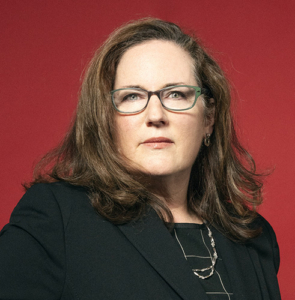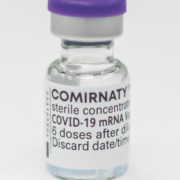Rise of the machines
Rise of the machines
Or, are you sure this wasn’t written by ChatGPT?
By Joshua Slatko • [email protected]
A thousand years from now historians (android historians, perhaps?) may look back at 2023 as the year that, after many stops and starts, artificial intelligence finally came of age. That coming-of-age is impacting pharma and pharma marketing and promotion no less than any other industry. AI is already deeply involved in the collection and analysis of the vast data sets that pharma marketers are using for segmentation and targeting – and as our friend Faruk Capan points out below, AI-driven marketing automation is growing more mature by the day. Then, of course, there are tools like ChatGPT, which offer a vision of AI actually developing content and interacting at a high level with patients and HCPs. Another one of our friends, Kristofer Doerfler of CMI Media Group, foresees a future not far distant in which AI touches nearly every part of the pharma marketing funnel, with brand managers growing increasingly comfortable with the idea of taking suggestions from increasingly sophisticated AI softwares. AI has been “the next big thing” for pharma marketers for some time now – see our Agenda piece from four years ago – but in 2023 it may finally be time to remove the “next” from that phrase.
Med Ad News: What was the word of the year in pharma marketing for 2022? Why? What will the word of the year be in 2023? Why?
Jeff Berg, president, AbelsonTaylor: The word of the year in pharma advertising for 2022 was “turmoil.” Despite the pandemic, 2020 and 2021 were years of rapid growth for our business, even with the “Great Resignation” as a backdrop. However, the turmoil in the labor market caught up with us, and unprecedented employee turnover slowed our business. Getting a significant number of new employees up and running, many of whom had never met their colleagues in person, was challenging. I can’t say that I would want a repeat of 2022, but the lessons learned should prepare us for greater resiliency in the future.
The word of the year for 2023 will be “recalibration.” As we all emerge from the COVID-19 pandemic, we must continue to recalibrate behaviors and processes that were so dramatically altered. We will have to adjust in many areas: What does hybrid work really mean? How do we train and mentor people who rarely come to the office? Are work and life truly a dichotomy? No one has definitive answers, but we must evolve and recalibrate our actions and expectations in 2023.
Faruk Capan, CEO, EVERSANA INTOUCH and chief innovation officer, EVERSANA: The word of the year in pharma marketing for 2022 was “omnichannel.” In pharma marketing, omnichannel is being used to increase the effectiveness of campaigns and enhance the customer experience. Omnichannel refers to a strategy for using multiple channels – such as email, text, and social media – to reach out to customers. Omnichannel campaigns allow companies to get creative and personalized messages to their customers, creating a more engaging and meaningful connection. AI is also playing a big role in pharma marketing, with companies using it to automate and optimize processes like customer segmentation and targeting.
For 2023, the word of the year is still omnichannel. But this year more than ever, it’s a data-optimized and AI driven omnichannel approach that connects all aspects of a patient journey to drive better engagement. The use of AI in pharma marketing is expected to have a major impact in the coming years, with experts predicting that by 2023, AI will be deeply integrated into pharma marketing operations. AI-driven solutions are already being applied in areas like customer segmentation and profiling, personalized marketing efforts, and predictive analytics to drive better business decisions. By 2023, AI-driven marketing automation is expected to be commonplace, allowing pharma companies to better understand their customers and tailor their marketing efforts accordingly. This offers the potential to drive greater ROI and more effective marketing strategies.
Derek Choy, co-founder and chief operating officer, Aktana: In 2022: Foundation-building. COVID-19 forced every company to rethink how they engage with their customers. Consequently, over the last few years, it has become very clear that digital engagement as part of an orchestrated, omnichannel model is here to stay. Companies recognize the urgent need to shift from strictly piloting the requisite technologies in isolated markets to operationalizing them at scale. As a result, lifesciences organizations focused on laying the foundation for what is to come in 2023 and beyond by investing in strategy, people, governance, data, and technology.
In 2023: Acceleration. Orchestrated, omnichannel engagement with HCPs and patients will accelerate in 2023. Being built on stronger foundations, intelligence platforms will be able to operationalize AI at scale to continuously personalize the right experiences for customers. In 2022, we saw early movers successfully deploy and operationalize omnichannel intelligence capabilities across up to 50 markets and across multiple brands. In 2023, we will see more companies hit this level of scale and impact, and quickly achieve greater return on their investments.
Rohit Gupta, VP of analytics strategy and transformation, Beghou Consulting: The word of the year for both 2022 and 2023 is “transparency,” specifically price transparency. There are three factors driving increased price transparency across the health care system:
- Legislative pushes: Recently enacted legislation will put downward pressure on drug prices and shine a light on price variances across the industry. The Inflation Reduction Act of 2022 allows Medicare to negotiate prescription drug prices for the first time, and the No Surprises Act aims to eliminate surprise billing and requires payers and employers to share more cost information with patients.
- The rise of biosimilars: Another tailwind lifting transparency and lowering prices is the rise of biosimilars (which are typically less costly than their branded counterparts). I expect the emergence of Humira biosimilars in 2023 will propel forward this segment of the industry and increase traction for other biosimilar drugs.
- Alternative manufacturing models: California’s plan to manufacture low-cost insulin and Mark Cuban’s Cost Plus Drug Company represent a shift away from value-based pricing and toward more price transparency for patients. I believe these efforts will spur others to pursue similar initiatives.
The expected upshot here is more consistent pricing across providers (e.g., prices for a large health system and a small community hospital will start converging). PBMs will likely take a haircut as they will see their margins from rebates reduced because of increased price transparency.
Pharma companies should support this push for transparency because, ultimately, it helps the patient by increasing access and making it easier for patients to adhere to therapy.
Margot Mahannah, associate director, behavioral strategy, Evoke Micromass: The word of the year in pharma marketing for 2022 was the same it’s been since 2020: Zoom. At least it sure felt like it. All jokes aside, in an ever-changing world that required innovative solutions on the fly, especially as we continued (and continue) to navigate a pandemic, the word for 2022 was agility. As marketers, we have spent a lot of time trying to figure out how to be effective and responsive in a landscape that will never go back to the way it was a few years ago. People have had to evolve their health habits (whether voluntarily or otherwise). Through this evolution, people have created and maintained new ways of engaging with their health, and it’s been our welcomed responsibility to meet them where they are, especially in the face of new personal priorities, rising (and changing) comfort levels based on new channels of information, and an even more digitally based society. Quick thinking and effective solutions were required in 2022 as we continued to operate with standards established during the pandemic. We can keep the agility that we have demonstrated moving forward, and we can certainly add to that strategically this year.
For 2023, the word that comes to mind is connection: doing our best to ensure that people do not get lost in the cracks while navigating their new “normal” during the pandemic and post-pandemic, especially those who have been traditionally underserved or overlooked. With the perception of things stabilizing in the coming year (let’s all cross our fingers), we have an opportunity to make our offerings even more personal and more meaningful. The great thing is that connection doesn’t have to be burdensome or awkward. It’s not about checking a box or forcing things to happen. With the advances of technology, we can deliver experiences that feel connective and personal without creating more work. When people feel comfortable asking questions, bringing up their goals and preferences, and being connected with those who are involved in making holistic healthcare decisions, the burden is reduced for all involved. This builds trust and brand loyalty over time. When done authentically, this sense of connection fosters a feeling that what’s important to an individual is not only meaningful but is also important to others. Encouraging a genuine connection with those who are navigating health challenges has benefits that bleed beyond the brand.
Connection is a human need. When people feel seen, heard, and connected, they are more likely to be active participants in their health. Normalizing open lines of communication, understanding what motivates people in a complex healthcare environment, and helping providers and pharmaceutical companies make connections that go deeper than prescriptions will be key this year.
Mike Monovoukas, CEO and founder, AcuityMD: In 2023, the word of the year for sales and marketers will be “precision.” We work closely with medical technology companies who generate massive amounts of commercial data. These data create unique challenges
– and a massive opportunity – for medtech companies to structure and integrate data into precise and actionable workflows for their commercial employees. In 2023, there will be significant revenue opportunities for medtech companies. But, to capitalize on these opportunities, they will need to leverage industry-specific AI technologies to drive efficiencies and personalization in their commercial approach by harnessing data to drive precision.
Mark Pappas, senior VP, innovation, CMI Media Group: AI will be the word of 2023.
AI is everywhere. On November 30 ChatGPT went live and revolutionized the way AI is leveraged for the average person. To say this is a seismic shift in AI would be a massive understatement. Now, without any programing knowledge, the public can harness the power of Generative Pre-trained Transformer (GPT) using ChatGPT, a new service from Open AI which was founded by Elon Musk, Sam Altman, and others in 2015. ChatGPT reached over 1 million users in five days – to put that in context it took the following companies a lot longer:
- Netflix – 41 months
- Twitter – 24 months
- Facebook – 10 Months
- Instagram – 2.5 months.
The use possibilities are endless. Everything from full referenced studies, speeding up insurance claims, writing web content to debugging, and explaining the errors in code – instantly.
Mindy Telmer, executive creative director, Greater Than One: The words of 2022 and 2023 are best known as initials. In 2022, “VR” (aka virtual reality) was on everyone’s lips, in part, due to Facebook’s transformation into Meta, the release of the Meta Quest Pro headset and the hype around the metaverse.
In 2023, the initials all anyone will be talking about, posting about, and using, is AI (aka artificial intelligence). A new wave of chatbots like ChatGPT and YouChat use artificial intelligence that could reinvent or even replace the traditional internet search engine. These AI chatbots will change the way we get our healthcare information, and if the hype is right, how we will do everything else in our lives going forward. Need more proof? Google‘s Search Business has declared a “code red” and described the efforts as make or break for Google’s future.
But you don’t have to just take my opinion as gospel. Apparently, YouChat doesn’t. Here’s what this AI engine, and apparently non-committal, chatbot had to say on the matter. “It is difficult to predict which exact word will be the ‘word of the year’ in pharmaceutical marketing for 2023, as there are many factors that will influence the language used in the industry. However, some words that are likely to be popular in 2023 include ‘innovation,’ ‘engagement,’ ‘transparency,’ ‘data-driven,’ ‘personalization,’ and ‘connectivity.’ These words indicate an increased focus on creating innovative solutions, engaging with customers in meaningful ways, providing transparency in all aspects of marketing, leveraging data-driven insights to inform decisions, personalizing marketing messages, and connecting with customers in more meaningful ways.”
All this talk about pharma lexicon has led me to start theorizing about the 2024 pharma marketing word of the year. My prediction is that instead of “googling it” we’re going to be “AI’ing it” next January.
Lynette Hunter, executive VP, director of client services, AbelsonTaylor: “Digital First” would be the best term to describe pharma marketing in 2022. As marketing teams built their brand strategies for 2022, they had no choice but to address the gorilla in the room – HCPs and consumers have evolved to consume and be influenced by more digital content than ever before. In 2021, U.S. adults spent over 13 hours per day with media, 60.5 percent of that total (just under 8 hours) with digital media. That share is estimated to increase to 63.7 percent this year [eMarketer April 2021].
With digital interactions setting the pace and new innovations advancing ways to engage in digital channels, marketers have to consider a digital-first approach to engagement with their brands. So, what is “digital first?” Some may describe the approach as “personalized,” “dynamic,” “omnichannel,” etc., while others may say it means creating a digital-only marketing plan. At its core, “digital first” is recognizing that we need to be thinking, creating, and designing experiences that meet customer expectations, starting with the digital implications first. With this approach, we establish a lead touchpoint with the brand via digital format, creating the start of a data fingerprint for that individual customer, and we design a journey that complements and meets their expectations via a pull-versus-push marketing method.
Key to executing “digital first” is that each engagement gives us the opportunity to gather data points about the customer and better inform future touch points along that customer’s individual brand journey, whether it be the next video media, email, or sales rep interaction. In 2022, we continued to advance this capability, leveraging AI and machine learning to even predict and automate media unique to each user. We now can deliver the most relevant content at meaningful moments, staying authentic when time is of the essence.
And why is time of the essence? Well, it isn’t just because HCPs are busy people with little time to spare. It’s our new culture norm as a society – instant gratification. Patience is incredibly low for experiences that don’t deliver on those expectations, whether you are scheduling a triple bypass surgery or ordering Starbucks.
So, if 2022 was “Digital First,” what will the word of the year be for 2023? I think it will be “Data.” As in data and more data, specifically first-party data, as we move into a cookieless future. Google predicts that by Q3 2023, most developers will adopt their new Privacy Sandbox APIs and begin phasing out third-party cookies in 2024 [Google, July 27, 2022].
With the desire to capture more first-party data, marketing teams and agencies will be leveraging an increased number of digital channels, yielding a sea of data points to swim through. In 2021, over 2.5 quintillion bytes of data were created each day [techjury Nov 26, 2022]. The successful marketing leaders of 2023 will identify what data points are most valuable to their brands at the onset of their campaigns and avoid getting lost at sea by staying focused on the measures that matter for their business.
Additionally, they will ensure that their digital platforms and agency partners are connecting the array of data points to tell more than things like clickthrough rates or conversions. They should provide a holistic view of each customer’s experience and the value behind each interaction that truly changes or reinforces our customers’ behavior in a positive way for the business. The result will be better insights for predicting future success with new customers.
Med Ad News: How might the various political and regulatory battles in Washington (or Brussels) impact the lives of brand managers and marketers in the coming year?
Jay Carter, executive VP, director of business development, AbelsonTaylor: Any curveballs from Inside the Beltway will likely come courtesy of regulators and payers from FDA and CMS. However, the recent acquisition of the Coalition for Healthcare Communication by the 4A’s (American Association of Advertising Agencies) will bring better education and advocacy for the medical communications industry. Look for live and virtual opportunities for communications companies’ staffs to ramp up.
Matthew Durham, director, global media, CMI Media Group: The EU’s recent ruling that Meta’s legal justification for targeting its users with personalized ads broke EU laws will be at the front of every European brand manager’s mind. Though campaigns using personalized ad targeting to HCPs are nowhere near as common outside of the United States, the ruling will still place a heightened focus from brand managers on the privacy protections of any suppliers being used in their campaigns. We may even see another wave of brand managers requesting audits of all suppliers’ data policy audits, similar to what happened when GDPR arrived. Outside of the EU, in London most of the headlines have been on the state of the National Health Service and how it is suffering from underfunding. Given how important the NHS is in Britain, brand managers will definitely want to make sure they are not doing anything that suggests they could be harming the NHS.
Mike Myers, managing director, partner, CrowdPharm: Regardless of the majority party in Congress, we will see continued pressures on drug pricing and access for patients in need. With a Republican House of Representatives, we likely won’t see the loss of the tax benefits firms receive when conducting healthcare advertising. This tax issue, however, is always lurking in the shadows and has not disappeared completely.
Med Ad News: What’s up next for marketing technologies in 2023? And what will brands be doing with AI and data science this coming year that they weren’t doing yet last year?
Terrence Brown, VP, digital strategy, CrowdPharm: While it’s difficult to predict exactly what new marketing technologies will emerge in 2023, as the field of marketing is constantly evolving and new technologies are being developed all the time, some areas that are likely to see significant advancements in the next few years include:
- Artificial intelligence and machine learning: These are already being used in marketing to personalize campaigns, optimize ad targeting, and improve customer experiences. In the future, they may be used even more extensively to analyze customer data, predict customer behavior, and automate marketing tasks.
- Virtual and augmented reality: Marketers will lean into immersive experiences for one simple reason: to increase conversions. The main cons in 2023 will be price and BSOS (bright shiny object syndrome). The threat of a global recession will be a reason for pharma companies to cut marketing budgets to the bone. It will be important for marketers to use new technologies only when appropriate and not simply for the sake of using them.
- Personalization: This is already an important part of marketing, but it is likely to become even more sophisticated in the next few years. Data and machine learning will be used to deliver highly personalized experiences to customers across all channels.
- Voice search optimization: As voice assistants like Amazon’s Alexa and Google Assistant become more popular, marketers will optimize their websites and content for voice search. One way to do this right now is through SEO.
- Video marketing: Video is likely to continue to grow in popularity to deliver product and brand information. Marketers will use video to engage with customers and deliver personalized, interactive experiences.
The marketing technologies of the future will likely focus on personalization, data analysis, automation, as well as immersive and interactive experiences.
Faruk Capan: In 2023, we can expect to see an increased focus on artificial intelligence (AI) and machine learning (ML) in marketing technology. AI can help to automate processes, personalize customer experiences, and offer insights that can help to improve marketing campaigns. Deep MarTech stack integrations will also become increasingly important as companies look to unify their marketing technology solutions. extended reality (XR) solutions, such as augmented reality and virtual reality, will become more widely used in marketing and advertising. Business intelligence (BI) tools will be used to gain insights and improve decision-making. Content marketing will continue to be an important part of digital marketing, with a focus on creating engaging, personalized content. Finally, social media and influencer marketing trends will evolve and become even more targeted as businesses look to reach their audiences effectively and efficiently.
Derek Choy: As brands begin to operationalize and scale the use of AI for omnichannel engagement, they will also work towards balancing technology that enables strategic marketing campaigns with their AI-driven technology. Overreliance on strategic campaign and journey technologies is proving to be difficult to scale because campaigns with complex branching logic can be too costly and complex to maintain. AI-driven intelligence technology is needed to prioritize and orchestrate which potential strategic actions will drive success and maximize ROI.
A balanced approach enables operationalization at scale by ensuring big picture strategy decisions are defined, while specific execution decisions are automated using AI, such as deciding the highest priority action, the best available channel to use, or the right time to engage.
Kristofer Doerfler, director, innovation, CMI Media Group: The explosion of AI and data science will touch on nearly every piece of the marketing funnel from creative development and optimization, to refined targeting, to idea generation, and even legal support. 2023 will be a year of greater testing with AI across the board with brand managers feeling increasingly comfortable taking recommendations from sophisticated AI software. There will also be an increasing overlap between AI, the Metaverse, and the spatial web (ie., the mixed reality world of AR and interactable screens), which will develop new media channels for brands and entirely new experiences for people that blends the digital and physical worlds, but will require enormous privacy sensitivity. The big word in AI for brands in 2023 is testing.
Jo Halliday, CEO and founder, Talking Medicines: Marketers are rapidly adopting advanced technologies to improve the efficiency of their operations and improve customer experience. AI is a powerful tool for better understanding and predicting and customer journeys from vast data volumes, making it easier to create effective marketing campaigns. The recent growth in programmatic advertising simply wouldn’t be possible without AI, allowing advertisers to optimize campaign performance, allocate spend more wisely, and provide a more effective measure of ROI.
Medical marketing is clearly more complicated given the highly regulated nature of our industry. However, that’s precisely what we at Talking Medicines aim to achieve with patients – providing medical marketers with actionable insights on the patient experience so they can improve both their efficiency and effectiveness.
However, over the past year, we have seen a giant leap in the way that AI can and inevitably will, impact how industries use marketing to sell products and services or change behaviors. From AI-based image generation to the current buzz surrounding ChatGPT, the most tangible advance is the ability of AI-driven platforms to draft copy, messaging, and even creative based on learned patterns and trends. So over the next year, we anticipate the growth of marketing campaigns, with AI at their core.
That’s not to say AI will suddenly replace humans. But it will now provide a us with a complementary tool which will make us more efficient and our work more effective at landing messages with our audiences. Marketers who are able to embrace and harness AI as it evolves and becomes increasingly sophisticated will lead our industry into the future and ensure that marketing retains a seat in the boardroom.
Bob Harrell, senior partner, Rebound Communications: A nuclear blast struck marketing and communications technologies at the brink of 2023 with the launch of OpenAI’s “ChatGPT” – which has gotten so much play on LinkedIn and the news that it’s already almost over-exposed. For anyone who wasn’t clear about the imminence and importance and of AI to do things that go beyond playing chess and planning logistics, applications like ChatGPT (for text generation) and DALL-E (for image generation) have provided the requisite wake-up call. With an initial investment of $1 billion from Microsoft – recently increased to $10 billion – Google is already freaking out about this dynamic app that is less of a search engine and more of a bona fide “answer engine.”
Within a very short time, expect extensions of ChatGPT to permeate the entire marketing, communications, and customer service space, with plug-ins and capabilities that bring the power of AI to enhance customer relationships across the entire spectrum of the customer journey. Similar to how “Dr. Google” has transformed the healthcare industry, “Dr. ChatGPT” will exponentially increase the utility, risk, and potential of digital application to help diagnose, treat, and eventually prevent diseases. Pharma marketers need to get ahead of this wave or become swept away by the tsunami of change, and the only way to do that is facilitate and encourage better coordination across their scientific, communications, and technological expertise.
We are also just at the beginning of an accelerating exponential trend for AI. The next version of ChatGPT will launch this year and will dwarf the current ChatGPT in capability. Consider that this version has been “trained” on 175 billion parameters, but the next version is being trained on 100 trillion (yes, with a ‘t’) parameters. AI is not only here to stay, but rapidly accelerating. Buckle up!
Jacob Harrison, director, e-commerce investment strategy, CMI Media Group: Amazon will lead the charge in the space of marketing tech. I see the use of Alexa and Fire CTV becoming a larger focus as sales channels not just for brand awareness plays. The use of QR codes and other forms of connected coding allows consumers to go from a simple commercial to a product pdp and check out within a matter of clicks. This will continue to evolve and become a greater part of audio as well. Commercials on Alexa will become shoppable. Fulfillment will be the second play here. The opportunity to get products to consumers faster, same day, within hours looks to be on the horizon as expansion takes place. Target is opening more fulfillment centers, Walmart is using stores to fulfil orders, and Amazon is always opening new sites across the country. However, even smaller players are taking part, such as Kroger purchasing Albertsons, effectively opening up 48 states to their products and services.
Corina Kellam, executive VP, experience and innovation, Ogilvy Health: We’ve been leaning on AI for diagnosis tools and creative efficacy for years, but I anticipate AI will be taking a role in speeding up the creative process. Even if we’re not leaning on it for final creative, it’s an efficient way to start with visuals for comps or other assets, or from the copy side to have research summarized quickly and thoroughly. Already, results are shockingly impressive and as they learn from us, they’ll only get better. Eventually, AI art generation will exponentially increase our ability to create high-quality creative at scale, quickly. Creativity will come from the concepts, prompts, and tweaks vs. entirely on the execution, and the sky really is the limit for what we’ll be able to make. I’m especially excited to explore data visualization with these tools.
David Laros, VP of digital strategy, analytics, and insights, Beghou Consulting: Pharmaceutical companies need to continue to work to engage with patients, enhance the overall treatment experience and improve adherence. I expect companies to increasingly invest in patient apps that help patients stay engaged through the treatment process. Patient apps are an untapped opportunity for rare disease drugmakers especially.
I also expect to see continued innovation on the patient communications front as pharmaceutical companies seek to cut through the digital clutter and engage patients with tailored and relevant messages.
Additionally, I think we’ll see the emergence of more powerful and integrated commercial analytics technologies in 2023. Companies need to adopt data analytics infrastructures that fully capitalize on artificial intelligence and machine learning. Ideally, these systems will drive many automated digital activities while providing guidance that commercial teams can consider alongside the sales force’s local knowledge as they work to devise effective commercial strategies.
The analytics capabilities are there. The data is there. Pharma companies just have to continue to work to bring all the pieces together in an integrated technology infrastructure.
Mike Monovoukas: In 2023, marketers will leverage data and technology to drive precise and actionable recommendations throughout their commercial teams. Unlike the past, access to data will no longer be necessary and sufficient to stay competitive. The MedTech commercial teams that are best equipped to harness data into clear and precise actions will outcompete and outperform their peers.
Pooja Ojala, VP, commercial content, Veeva Systems: Content automation will deliver as AI fails to live up to the hype. Given the demand to deliver a steady stream of content to meet HCPs’ needs, pharma marketers must react, create, edit, and adapt quickly. While artificial intelligence (AI) has often been a go-to capability and will continue to help, the true content accelerator in 2023 will be automation.
Automation enables organizations to act fast without requiring high volumes of data – and it doesn’t come with the same risks associated with AI. Many teams are already leveraging automation using modular content to create content faster, review and approve quickly, and reuse content across channels. And technology like digital asset management (DAM), medical, legal, and regulatory review (MLR), and content authoring tools will help drive further acceleration.
As lifesciences companies have discovered, the human touch still serves an essential and complementary role in the MLR process alongside automation. But organizations will continue to strike the right balance between automation and the domain expertise MLR teams bring to the table to ensure compliance.
Christie Volke, VP, media strategy, AbelsonTaylor: This year will continue to focus on personalization and automation of “next best actions,” with AI and data science coming together to drive growth for pharma brands. Collecting more data, analyzing it faster, and connecting it to media planning and buying platforms will allow for more real-time decision making on audience priority and messaging. It will also create greater cost efficiency for brands by helping them prioritize funds.
Real-time identification of individual providers, predictive modeling, social influencers, content development, and dynamic messaging will gain momentum in pharma with this strengthened union of AI and data science. Making it happen isn’t a question of “Can pharma be more dynamic?” The real question is “How do we help regulatory teams become more comfortable in a dynamic space?”
Ken Winell, executive director, consulting, Greater Than One: 2023 promises to be a tipping point for many marketers who will be integrating conversational and search AI into marketing. Advances in graphics and chat such as Dall-E and ChatGBT will become more commonplace over the next 12-24 months, as long as some boundaries and ethical/copyright compliance are incorporated. This will allow for more personalized and dynamic content generation, allowing marketing campaigns to improve efficiencies and tailoring content based on user/visitor behaviors. On the analytics side, incorporating AI into data visualization and predictive behaviors will help keep the closed loop marketing business model as a standard. In addition, more immersive experiences including augmented and virtual reality will find a receptive audience for healthcare practitioners, as mechanism of action/disease and procedural training and education and an ability to converse in a walled garden metaverse with colleagues.
Med Ad News: Health equity has recently become a matter of the first importance for brands and companies in the healthcare space. What will pharma brands need to do in 2023 to be sure that they are providing equitably in every sense for all potential patients?
Jay Carter: Focusing on providing equitably in every sense for all potential patients can get in the way of making things better now, while we’re working toward the greater goal. As healthcare marketers living in an omnichannel digital world, we need to:
- Understand the disease states and challenges of the patients for our clients’ brands.
- Understand the specific disease- and culture-driven issues for each segment of patients.
- Strive to meet those patients on their level.
Done correctly, this process can increase health equity in an effective and meaningful fashion.
Kristofer Doerfler: The greatest opportunity of pharma advertising is the chance to reach underserved communities with quality healthcare information that will improve their lives, and so first and foremost there should be more financial investment from brands in reaching and supporting these communities through media. This does not stop at the awareness stage however as brands should look to provide support to underserved people throughout their journey with a disease so that they can maintain their Rx adherence and better reach trained medical professionals. There is a growing trust gap in both the advertising and pharmaceutical industries between brands and consumers due to growing mistrust in traditional information sources, which leaves an opportunity for savvy brands to stand out by focusing on building trusted relationships over long periods of time with underserved communities.
Jo Halliday: According to CDC, health equity is when every person has the opportunity to attain their full health potential and no one is disadvantaged because of social position or other socially determined circumstances.
So, for there to be “true” health equity, we really first need to understand more about people, their social circumstances, how they talk and what they talk about. Traditionally, pharma has always received its patient intelligence from healthcare practitioners, those in contact with patients. HCPs would then be asked for their opinions on how brands are performing, through surveys and focus groups. This cross sectional feedback has been the status quo.
However, the data revolution has changed this. Anyone with a digital footprint (pretty much all of us) contributes data points which can be analyzed to better understand our personal circumstances, behaviors, and feelings. AI has given us the power to analyze large data sets from disparate sources, allowing us for the first time to truly listen to and understand how specific audiences are feeling.
That means we as marketers can more effectively use language, which is inclusive, inspiring, and empowering and will resonate with these audiences. It also means we can learn more about the behaviors of specific sub-groups of patients, based on personas or socio-demographics – so we can more accurately plot their patient journeys. That in turn allows marketers to create tailored campaigns or messages which speak to those specific journeys and improve the chance of delivering better health outcomes across all populations. That, after all, is the ultimate aim of achieving health equity.
David Linetsky, senior VP, Phreesia Life Sciences: One of the strongest ways for brands and companies to prioritize health equity in 2023 is by centering the patient voice and experience in content creation and messaging efforts. To make progress in health equity, the industry must provide all types of patients, no matter their demographic, with resources and support to address the specific barriers impacting their care access and communication. These needs may range based on factors such as the patient’s race, gender and economic status, but providing them with relevant health materials they need most – from copay assistance to medication information to doctor discussion guides in their preferred language – is vital to helping patients navigate their healthcare journeys.
Partnering with vendors that can safely leverage demographic data in a privacy-safe manner can help brands that are seeking to promote equity through their outreach efforts. Delivering more personalized content to all types of patient groups, especially vulnerable and marginalized communities, at the point of care ensures that important health information on topics such as preventive screenings and vaccinations reaches the most relevant patients at critical moments of receptivity to help empower them to make more informed medical decisions.
Yolanda Macias, director of diversity and inclusion, AbelsonTaylor: Health care has largely focused on serving the dominant population, when in the real world all races and nationalities have health concerns and healthcare needs. Health equity becoming a matter of first importance is long overdue and efforts are far behind in ensuring that healthcare systems and the surrounding healthcare space are equitable.
While there are several new efforts in place to ensure everyone is afforded equitable care and access, pharma brands can also play a role in supporting health equity. They can serve as advocates and allies when deciding what drugs and whose stories to highlight in their promotions and patient-service initiatives and do so in an authentic way, by involving voices from the community in all aspects of the business. Pharma brands should make every effort to uphold the saying, “Nothing about us, without us.” This means connecting with underserved communities and searching for patient needs that have not been recognized or prioritized.
Pharma brands are also in a unique position to challenge the status quo, change policy and processes that undermine health equity, and require that stakeholders give health equity the same urgency.
Jenn Reilly, senior VP, account director, CrowdPharm: With the onset of the pandemic and the ongoing deterioration of mental health and wellness, patients around the world do not feel they are being seen, supported, or cared for adequately. At the 2022 HLTH conference, a group of advisors and panelists discussed how major cracks in the healthcare system continue to limit access for many patients. Panelists identified three key areas of health care – clinical trials, commercial marketing, and community – that can make a significant difference in reaching patients across all demographic groups.
So how do we begin to eliminate the cracks? For starters, increased transparency. Over the past few years, patient-centric marketing has become the cornerstone of how healthcare marketing agencies reach patient and caregiver audiences. The focused effort to include real patient voices in materials and communications is now more prevalent than ever. Why? Because the patients are the experts of the journey. The hurdles they face getting a diagnosis, the denials around access to medications, or the lack of support when starting a new therapy are daunting challenges that only intensity when emotion, desperation, and lack of education are added.
In recent years, the number of patient advocacy organizations, like Power to the Patients, have increased. Those on the front lines concur, acknowledging that so many patients do not speak the same language as healthcare professionals when it comes to understanding what a benefits investigation or prior authorizations is, or the course of action needed in the instance of a denial in medication coverage, or even how to seek copay assistance.
As healthcare marketers, it is imperative that we increase our efforts to better educate patients on all aspects of their medications and that includes supporting all avenues that grant them access to therapies and providing assistance with costs.
Med Ad News: What do brands have to do to optimize and maximize the effectiveness of their sales rep teams in the new year and going forward?
Derek Choy: Sales reps continue to play an important role as part of a well-
orchestrated, omnichannel customer engagement strategy. However, their roles are more dynamic and complex than ever before. Typically, they are managing more accounts, choosing from more channels, making decisions based on more data, and having to coordinate with more activity occurring around them. Consequently, reps need to be better supported with tools like AI-driven suggestions and insights offering next best action recommendations to truly optimize their HCP engagements across all channels.
Brian Cunningham, senior VP, media, CMI Media Group: As sales teams continue to rebuild post-pandemic, they are motivated to simultaneously retool and leverage in-house data to evolve their customer engagement model. New expectations are that – like in marketing – sales is operating in an omnichannel world today. And that means more hyper-personalized communications – not just knowing what they last heard from the rep, but what other brand information they have already consumed in any number of other promotional channels. What might have been seen as invasive is now going to become an expectation from the HCP customer that the rep knows what they’ve learned and can continue to build on that knowledge, even if it has been months since the last face-to-face visit. To do this, stakeholders will need to have not just better visibility of where their brand messages live, but the precision “near-time” data to know what they have heard to empower each rep’s ability to be efficient in the short time they have with the HCP.
Ingrid Dahlin, managing director, Account Services, CrowdPharm: There is always the need for stronger alignment between marketing and sales. Marketing teams spend a considerable amount of time in the development of tools and resources and provide the necessary sales force training and educational support to ensure effective implementation. However, utilization of these resources can often present challenges. It’s imperative that marketing teams involve regional sales leadership early in the ideation of initiatives. This can result in developing localized tools that can augment broader marketing efforts. It’s also important for marketing teams to establish the value of initiatives, utilizing rep “champions” to help communicate how the initiatives are a critical component of the brands success. Lastly, supporting rep efforts with non-personal “air-cover” to reinforce messaging is a powerful tool to gain alignment, elevating brand awareness and interest across target audiences.
Christopher Dimmock, senior VP, integrated strategy, AbelsonTaylor: Over the last three years, pharma marketers have invested significantly in new technologies and data-driven non-personal promotion. Meanwhile, HCPs are taking meetings again. In 2023, brands should look at the shared roles of non-personal promotion and sales in helping identify and meet the individual needs of healthcare providers.
Through data-driven engagement practices, pharma brands can not only optimize their non-personal promotion but also inform richer, more productive conversations within their personal promotion. The increased ability to match individual provider data with digital content consumption and engagement data helps inform deeper insights into the current needs and mindsets of our HCP audiences.
Leveraging customer experience engagement data helps sales reps understand what specific needs the HCP is looking to fill and enables sales calls focused on needs-based segmentation. In other words, by linking the insights gathered in non-personal promotion with call plan and support material, sales reps can continue the audience-generated dialogue. Knowing how HCPs have interacted with responsive content helps expedite the HCP decision journey, enables trial, and increases conversion. Customer experience engagement data can help sales reps understand what needs the specific HCP is looking to fill and enable the design of target models based on a range of mindsets and knowledge.
Kristofer Doerfler: Sales teams should consider incorporating more augmented reality (AR) and virtual reality (VR) into their sales pitches depending on the complexity of the product. While this may seem unconventional, the technology behind AR and VR has grown significantly where sales reps can provide high detail 3D resolutions of the human body that can brought to life in a room, over a person’s body, or in a digital space with a high degree of accuracy. This digital rendering can turn a highly complex procedure or side-effects into something that is easily explainable and interactable, with use cases already being applied in surgery, women’s health, and more. Additionally, these same 3D digital assets can be re-used to create future experiences (ie., build a digital asset library), which can then also be used in advertising to build 3D ads or consumer experiences.
Rohit Gupta: Continue to integrate in-person and digital customer interaction models.
The COVID-19 pandemic was an accelerator of digital promotion. To maximize the return on a company’s digital investment, the commercial team needs to break down silos and ensure digital and in-person promotion work together seamlessly to engage healthcare professionals.
In line with this closer integration between digital and in-person promotion, companies need to empower sales reps with more analytics-based insights that they can act on (think of it as a man-plus-machine model). Pharma companies also need to rethink their incentive compensation strategies to ensure they reward the right behaviors and retain top talent in an era of micro-launches when they must do more with less. Instead of focusing solely on sales outcomes, companies need to reward reps for performing the activities that will drive long-term engagement with decision-makers. This shift in incentive compensation strategy from outcomes to activities is especially important as large health systems increasingly dominate the market. Reps need to strategically navigate these complex entities and build relationships with the various stakeholders who influence prescribing decisions. Selling into a health system is naturally a much longer process than selling into an independent practice.
Bob Harrell: A key strategy for brands to deliver on this year and beyond is optimizing the effectiveness of sales reps and better integrating personal and non-personal promotional efforts. The shift from multichannel to “omnichannel” marketing involves putting the HCP and other customers at the center of all engagement, and providing dynamic, data-driven experiences as needed at each point in their journey.
By better connecting stakeholders through technology platforms, pharma brands can make the most efficient use of the combination of sales teams and digital campaigns, which augment and enhance each other. Crucial to success is empowering brand teams with transparency and control across both marketing and sales to better incorporate the voice of the consumer throughout the product lifecycle, articulate treatment differentiation and a compelling value proposition, and provide practical use cases. Done well, this can ultimately cut through the noise of the busy days of every HCP and patient.
Mike Monovoukas: In the medtech industry, the role of the sales rep is rapidly evolving. However, the one thing that will remain core to the sales rep’s role is educating and training surgeons on how new medical technologies can benefit patients and providers. To maximize the effectiveness of the medtech sales rep in 2023, commercial organizations need to empower reps to build closer relationships with the surgeons and accounts they serve. In 2023, the paradigm will shift from “big brother” tracking activities of sales reps, to a “helping hand” enabling reps to better perform their critical responsibilities of educating providers on the benefits of new technologies.
Dan Rizzo, VP, global business consulting leader, Veeva Systems: As access to HCPs rebounds from historic lows during the pandemic, building valued relationships and meeting customers on their terms with the right mix of in-person and digital tactics is essential. As Veeva Pulse data shows, the use of video as an additive channel to in-
person can increase promotional response three times over in-person alone. This will force a shift in how companies think about incentive compensation.
In 2023, omnichannel behaviors will directly influence incentive compensation models by correlating successful engagement data to successful sales outcomes. Companies will begin to shift away from the traditional sales target approach to a blended model that rewards the right rep behaviors that drive HCP engagement.
Traditional sales reporting will continue to be an important part of the incentive compensation strategy as a lagging indicator. Reliable, measurable omnichannel behaviors, such as the use of video to complement in-person engagement, will become leading indicators.
Companies that adopt this blended model will be able to recognize performance gaps earlier and, for the first time, align incentives across the entire commercial ecosystem, including sales reps, key account managers, and medical science liaisons.
Michelle Whitlock, executive VP, specialized engagement solutions, Ogilvy Health: The playing field has changed for healthcare sales representatives. Even before the pandemic, in-person access to healthcare professionals (HCPs) by sales reps, the long-held industry yardstick, had been in significant decline. Then in-person meetings plummeted to historic lows during the pandemic. However, according to a recent Veeva Pulse Field Trends Report analyzing 600 million HCP/rep interactions globally, HCP access has now rebounded, albeit with significant differences. Interestingly, the data revealed that HCP access (defined as a willingness to meet with reps either in-person or via video) has rebounded to 60 percent across specialties. However, more than half of those accessible HCPs meet with reps via a hybrid mix of in-person and virtual video calls. Further, surveys capturing HCP preferences show that many want product information via new channels and in digestible bites, when and where they are ready to consume.
Meeting HCPs on their terms is just one of a number of seismic shifts reshaping the healthcare marketing landscape and pushing brands to reevaluate their field force strategy.
However, while we may be in a chaotic and rapidly changing environment, brands shouldn’t lose sight of sales effectiveness fundamentals like ensuring reps add tangible value in every interaction. One key way brands can do this is by harnessing data to optimize rep/HCP interactions, from call planning through follow-up. There is no more potent tool to generate relevant, timely, and actionable insights for reps to share with today’s often overworked and time-constrained physicians.
For example, in our Market Access practice we are seeing savvy brands deploy data-enabled reps to identify, plan, and pull-through market share opportunities on a local market-by-local market, and plan-by-plan basis. This is not necessarily a new strategy, but what has leveled-up is the richness and depth of the data and tech capabilities that generate insights and allow them to be served to HCPs in personal and non-personal ways. Data-enabled reps can identify and show an HCP exactly which local, regional, and national insurance plans or PBMs (and associated employers) cover their product, along with important restriction criteria details needed to close the “last mile” between prescription and fill. Plan formulary status changes are available in days, not months, for reps to share with HCPs. And digital details enable reps to generate custom leave-behinds to print or email to their customers, delivering digestible, compliant content for HCPs to access when and where they want. Finally, data-powered coverage and support resources are also used to engage practice stakeholders beyond the prescriber, such as office staff, reimbursement specialists, etc. All of this information is then reinforced through an expanding channel mix that includes website plug-ins, EHR messaging, SMS, and social platforms like TikTok where data, messaging, and tech converge.
Formularies and utilization management policies are tightening in a healthcare system taxed by the pandemic and the rising costs of chronic care, among other stressors. So today more than ever, HCPs need to have actionable coverage and affordability details for the plans they see most in their practice. Sales reps who provide that level of insight help their customers start or keep patients on essential therapies, and ultimately are more effective at helping to drive market share for their brands.
Med Ad News: How do you foresee pharma’s marketing media mix changing – or not changing – in 2023? How will the various channels develop and change in the new year?
Sarah Caldwell, general manager, Veeva Crossix Analytics: In 2023, pharma marketers will continue diversifying their DTC media mix and investing in digital media channels like streaming TV and online video, where consumers are spending more of their time. Data in 2021 from Veeva Crossix’s bi-annual Healthcare Advertising Trends Report showed streaming TV made up roughly 8 percent of all impressions measured. However, in the first half of 2022, that number increased to more than 12 percent of impressions. This growth is expected to remain in 2023 and marketers need to stay agile to meet rapidly changing consumer behaviors.
The buying process for streaming inventory will also continue to evolve. Pharma marketers are not solely buying inventory directly from TV networks. In fact, a quarter of streaming TV impressions were bought programmatically in the first half of 2022. This makes it easier for marketers to use health audience segments, and, in doing so, will help brands better target advertising campaigns to reach precise patient populations across channels.
Jason Celestino, lead client experience manager, Phreesia Life Sciences: I’m very excited for 2023 because I believe industry experts have:
- Become highly skilled at bringing to life more data-driven, digital tactics across all channels, and …
- Debunked the myth that you must sacrifice reach for quality engagement.
How will these advancements affect media mix in the new year? I think we’ll start to see media dollars increasingly shift away from linear TV. While you have the usual suspects — online video, social, and search — that marketers are optimizing toward, what I’m most thrilled about is the resurgence of the point-of-care channel. Companies that have always championed point of care are spending more than ever on it, and companies that weren’t aware of or only had a basic understanding of the channel are now viewing it as a vital component of their media plans. Here are three of the biggest reasons for this:
- Digital innovation. The point of care is no longer just wallboards and magazines in a waiting room. Today, there are several digital tactics at the point of care that allow you to reach high-
quality audiences, at scale, with messages that are tailored to where that patient is in their journey. - Brand awareness is low by the time patients make it to the point of care. Despite pharma contributing more than $280 million in TV ad spend, a Phreesia survey found that only 5 percent of patients in one condition recognized a leading brand when checking in for their appointment.
- Cost efficiency. A recent case study from Veeva Crossix that evaluated the impact of a brand’s direct-to-consumer (DTC) campaign found that the point of care was the most cost-efficient driver of conversion. Representing just 2 percent of the campaign’s overall media investment, the point of care was attributed to driving 17 percent of new-to-brand prescriptions (NBRx). These results, combined with the fact that the point of care is not maxed out show the untapped potential that awaits marketers, who will run — not walk — to this channel in 2023.
Bob Harrell: Readers will be shocked to hear this, but pharma’s marketing media mix will shift increasingly to digital in 2023 and beyond. This is likely similar to the answers given in this annual feature over the last 10 (or 20?) years. So, what’s new for 2023?
First, the industry experienced a state change during and now after the global pandemic. From an exponential boost in the use of telemedicine to ballooning digital budgets for pharma marketers across nearly all disease states, digital is eating larger and larger shares of the overall media mix. Given that long overdue and inexorable trend, pharma brand teams need to ensure seamless orchestration between their clinical, communications, and technology experts so that nothing gets “lost in translation” when audience-specific content is translated throughout the multichannel ecosystem.
Second, in addition to the shift in investment from other channels into digital, the maturity and velocity of the process is accelerating. It has become almost trite to say “pharma is behind other verticals” because it’s been the common refrain for so many years. However, while this may still be true by some measures, that gap is starting to close. And that gap must close due to the changing fiscal environment. In the past, large marketing budgets and high company margins covered a lot of sins, making it (relatively) easy to appear successful, even when it was not clear that the marketing was driving the business – or even reaching a >1.0 ROI.
Today, there is much more pressure on lifesciences businesses in terms of margins and growth, which will drive a new urgency in how we adopt digital in a way that is data-driven, accountable, and high performance. In short, we’re entering a new age of digital for pharma, which is focused on both “more” and “better.”
Toby Katcher, VP, video investment, CMI Media Group: Although ad spending growth will slow in 2023, buyer investments in Connected TV will continue to increase by double digits. The total amount spent on advertising is anticipated to increase by 6 percent annually, a growth rated 3 points lower than anticipated in 2022. This coincides with a downturn in the advertising market brought on by the impending recession.
Expect buyers to focus spending on digital channels, with OTT, inclusive of CTV, securing the largest share in 2023. This shift in spending comes at the expense of traditional ad channels like linear TV but coincides with the viewership changes as time spent streaming has officially exceeded that of traditional linear TV.
Italia Marr, associate media director, Greater Than One: I envision paid social being a much larger part of the pharma marketing media mix. Pharma is exploring it now, and as companies and brands learn from their first forays into social – and see success – that will set precedent for others to join. Existing channels will get smarter – a great example is the ability to execute triggered messaging across channels like digital, email, and EHR based on pre-established business rules. Smarter techniques like that will continue to be leveraged to ensure the right message is getting in front of the right customer at the right time.
Christa Volke: While the metaverse seems like an obvious choice, it likely won’t be as disruptive in the pharma landscape as it may be in other business verticals. Pharma brands will add it to their ecosystem and monitor to identify use cases, but most brands won’t jump into metaverse activations in 2023.
More realistic changes to pharma’s marketing mix will still focus on connectivity between HCPs and patients, but through the one-to-one-to-many aspects of social media. Brands are gearing up for significantly heavier investments in social from all sides this year – paid, owned, and organic – with some experts even dubbing social, “the new search.” Since the metaverse will provide brands an opportunity to interact with individuals more dynamically, we should start to see a further blurring of social, search and engagement. Real-time AI chats are already a great example of brands using social concepts to provide more personal engagements.
Med Ad News: What skills or offerings are brand managers going to expect from marketing agency partners in 2023 that they might not have expected in 2022? Why so? What other changes might be brewing in the agency world?
Jo Halliday: Increasingly we’re seeing brand managers seeking and demanding data-driven solutions from their agency partners. On the back of an explosion in the growth of marketing technologies which add value to the marketing function, this shouldn’t come as a great surprise. Agencies have been investing in data analytics for years now, with a significant step up in 2022 from the investment in data management and analysis tools, through to hiring data scientists and other experts to make sense of the vast data that they collect. However, rather than existing as a standalone team in the corner or the office (much in the same way as social media teams were first introduced to agency land), in 2023 data must now be embedded across agency functions, from strategy and planning through creative, media buying and measuring ROI. With a global downturn looming, understanding and interpreting data to give actionable insights will become increasingly important. Budgets are likely to tighten and being able to justify a spending ask with data-based evidence could be the difference between winning new business and not. Making it easier to find insights will give creatives more time to do what they do best – create!
Lynnette Hunter: Table stakes in 2023 will be strong actionable analytical skill sets from marketing agency partners. While agencies have been providing analytics reports for years, the depth and actionable insights from those reports have been nominal in driving business growth. The challenges have been siloed customer and campaign data and a lack of sharing and connecting data across agency partners. This often exists within entire organizations, with marketing teams and commercial insights teams deprioritizing the bridging of their own data sets internally.
In the past, brand managers would accept the data limitations, believing there was only so much they could do. General leading indicators of tactic performance would be enough to convince senior leaders that their initiatives were working. Moving forward, that isn’t going to hold up when the tough questions are asked about business growth and return on marketing budgets. The capabilities exist to build multitouch attribution models and prove the impact each initiative is having in driving customer behavior change, brand uptake, and utilization.
Agency partners who bring stellar strategic thinking, breakthrough creative ideas, and innovative engagement solutions also need to be sharing their approach to business growth measurement from the start of a campaign. Planning and building the data infrastructure to support actionable learnings and optimizations needs to be an initial discussion, not an afterthought once tactics are in market.
Mike Myers: With privacy concerns driving decreased tracking of customers’ clicks, visits, and opens, brand managers are going to be leaning into their agency partners to identify and implement ways to track and confirm the impact of marketing and promotional efforts.
Traditional agencies, like many firms who believe that much of their “mojo” comes from people gathering in their fixed-wall offices, will be battling with their team members who want to work remotely more often than one or two days a week.
Med Ad News: What do you think is an important trend for pharma marketers that is flying under the radar?
Jeff Berg: The idea of therapy warranties, an innovation in reimbursement models driven by the costs of cell and gene therapies, is a trend that’s flying under the radar for many pharma marketers.
There are more than 20,000 prescription drugs approved for marketing in the U.S. and the conversation about drug pricing is always on the radar. By contrast, there have been only 20-plus cell and gene products approved in the U.S. Many of these are remarkable, lifesaving therapies priced in the high six-figures to the millions of dollars. But because the uptake of these therapies has been low, the cost burden has yet to have a significant impact. However, much is happening behind the scenes that may ultimately spill over to the rest of the market.
Which brings me to my point about therapy warranties. According to Brooks Wildasin, VP of product management at CareMetx, a company focused on improving patient access to specialty medications, “a therapy warranty allows manufacturers to stand behind specialty therapies and ‘guarantee’ that certain results are going to be achieved by the patient population. This eliminates many of the questions around the therapies themselves and helps to support and supplement the available data (e.g., clinical trials).”
While the idea of a therapy warranty seems simple, it requires robust performance data tracking to implement, and the complexity of acquiring these data is significant. But I believe that new ways of data acquisition, including AI, will evolve because of cell and gene therapy pricing, that new reimbursement models will be developed, including therapy warranties, and that these innovations will eventually spill over into the much larger marketplace.
Jay Carter: A couple of trends are going to potentially affect that all-important “Price” element of Philip Kotler’s famous 4 Ps of Marketing. In 2023 we’re going to see PBMs increase their efforts in copay Accumulator Adjuster Programs (AAPs), which will impact the patient’s ability to pay for expensive products, likely reducing utilization. At the same time, the influence of 340B hospital discounts has the capacity to negatively impact revenues for important products. (Fun fact: in 2020, 340B program sales accounted for 13 percent of total U.S. pharmaceutical sales.) The moral of the story: Hug your market access director, who is keeping you whole in treacherous waters.
Derek Choy: The quickly evolving role of the medical science liaison (MSL).
Medical affairs teams are beginning to follow their counterparts in commercial operations in seeking to provide personalized engagement for ever-expanding targets to deliver unbiased scientific information in the most useful formats and channels. There is a growing opportunity to support those teams with smart technologies and AI, to optimize engagements with key opinion leaders for content, timing, and channel and maximize return on effort. This will help MSLs build stronger relationships with key opinion leaders while addressing medical queries, delivering education and information faster and more effectively. Also, technology enabled, compliant collaboration between sales reps and field medical and clinical affairs teams has the potential to dramatically streamline the experience for a KOL interacting with various stakeholders within a company.
Kristofer Doerfler: Blockchain. I know, I know, when hearing this word you likely think of crypto-currencies and NFT art, but the many of the most important use cases involve data management, consumer privacy, loyalty programs, and media management. There are new advertising services which use blockchain technologies to provide enhanced transparency to brands without jeopardizing consumer privacy and the medical space is leveraging blockchain to cover needs from inventory management to digital security. The use cases for blockchain and decentralized ledger tech will grow significantly over the coming years, so don’t be fooled by all the talk around crypto-currencies.
Allie Reynolds, senior director, commercial content strategy, Veeva Systems: Dynamic digital content will drive MLR, health authority collaboration. The pivot to modular content, personalization, and the expanding number of content channels are driving high volumes of submissions to global health authorities. The sheer amount of new dynamic content, including video, web, and CLM, requires a different way to review this content at speed and scale. In 2023, we anticipate more collaboration between MLR teams and health authorities to establish new guidelines for streamlining the submissions and approval process.
Changing these entrenched processes will take time because it’s such a fundamental shift in approach. For example, allowing one submission for 20 versions of an email to support personalization. And there will need to be more collaboration across geographies and authorities, including the U.S. Food and Drug Administration’s Office of Prescription Drug Promotion (OPDP).
With compliance at its core and the right tools, content teams will shift toward a more collaborative approach to working with health authorities. Establishing new guidelines and streamlined processes will usher in a new era of dynamic digital content review.
 |
Josh Slatko is contributing editor of Med Ad News and PharmaLive.com. |























